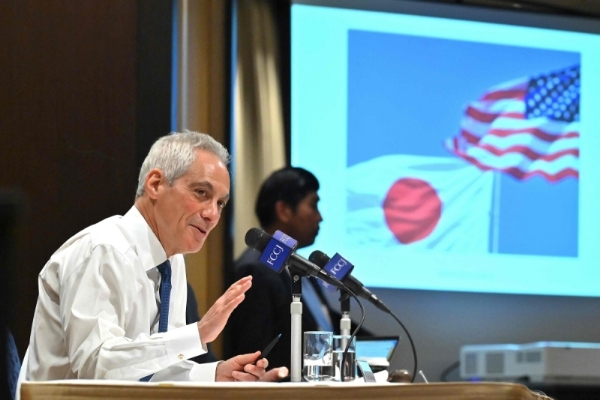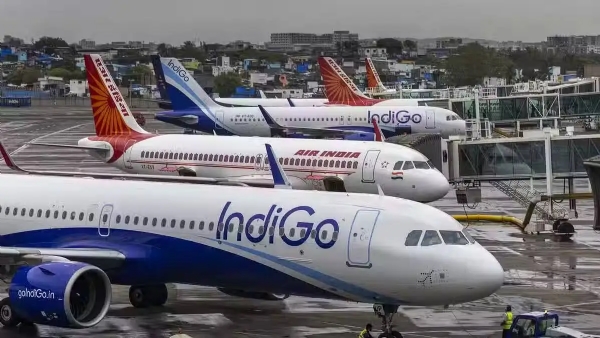#SecurityScan 73: Hindustan Aeronautics at Wings India 2024, India's Lithium agreement with Argentina & more
Free of Washington’s global security commitments, Beijing can sit back and watch the conflict with the Houthis unfold.
Total Views | 244
This article is a summary of important events that have taken place in last one week affecting, India's national security.
News In Brief
China’s $6.3 Trillion Stock Selloff Is Getting Uglier by the Day
Property sector’s slump and geopolitical risks are negatives, China’s valuation discount to India hit a record this week. Chinese stocks just capped another dismal week, with a gauge of mainland firms listed in Hong Kong languishing at the bottom of global equity index rankings for the year so far.

Grim milestones have kept piling up in recent days: Tokyo has overtaken Shanghai as Asia’s biggest equity market, while India’s valuation premium over China has hit a record. Locally, a meltdown in Chinese shares is wreaking havoc on the nation’s asset management industry, pushing mutual fund closures to a five-year high.
US senators introduce bill to counter China’s dominance in critical minerals
Legislation requires US federal agencies to submit report to Congress on world’s critical minerals and rare earths to address ‘information gaps’
The assessment must include which resources are under the control of a ‘foreign entity of concern’ – China, Iran, North Korea or Russia.
China lab simulates attack on US warships using space weapons, hypersonic missiles
Laboratory that works on electronic warfare equipment for PLA shows how satellites and missiles might be used to strike an aircraft carrier group. Researchers say ‘electronic warfare in outer space using low-orbit satellite constellations has become an important means of information warfare’.
U.S. wants Japanese shipyards to help keep warships ready to fight in Asia

United States and Japan are looking to make a deal for Japanese shipyards to regularly overhaul and maintain U.S. Navy warships so they can stay in Asian waters ready for any potential conflict, U.S. Ambassador to Japan Rahm Emanuel said on Friday.
"China watches what ships are coming in and out. It is not like this is a secret, they know what's happening. So therefore, they take an evaluation of your deterrence," Emanuel told reporters at the Yokosuka naval base near Tokyo.
UK military is too small to fight, US generals warn
Troop numbers are likely to fall below 70,000 within the next two years, casting doubt on the country’s combat capabilities, especially the British Army.
European and American generals have questioned whether the UK can still be considered a top-level fighting force, with new analysis revealing the army will have fewer than 70,000 soldiers within two years.
Figures compiled by The Times show that if the army continues to lose troops at its present rate, the number of regular soldiers will fall to 67,741 by 2026 — smaller than the United States’ special operations forces alone.
Countering External & Internal Security Challenges
Indian Army marks 76th Army Day with Chief Manoj Pande's call for 'Year of Technology Absorption
On the 76th Army Day, Chief of Army Staff General Manoj Pande declared 2024 as the 'Year of Technology Absorption,' emphasizing the Indian Army's commitment to technological advancements. Pande paid tribute to fallen soldiers and underscored the evolving nature of warfare. The decentralization of events to Lucknow from Delhi Cantonment marked a departure from tradition.
Lucknow hosted its first parade, shifting from Delhi Cantonment for 76th Indian Army Day on January 15. The day commemorates General KM Cariappa taking command in 1949. The theme is 'Year of Technology Absorption'. General Manoj Pande emphasizes transformative change through technology.
President Murmu commended the Indian Army's pivotal role in national security, expressing admiration for their professionalism and selfless devotion during various operations. She saluted the sacrifice of brave soldiers and conveyed continued success to the Army.
PM Modi praised the Army's courage in facing external threats and aiding during natural disasters, highlighting its contribution to nation-building
Myanmar rebel group claims control of town bordering India, Bangladesh
The Arakan Army, an ethnic armed group in Myanmar's Rakhine state, has declared its control over Paletwa, a significant border town with India and Bangladesh. The insurgency, involving anti-junta forces backed by a parallel pro-democracy government, has intensified, posing a substantial challenge to Myanmar's military government since the 2021 coup. The Arakan Army vows to manage the area's administration and law enforcement. Concurrently, reports suggest violations of a recent ceasefire agreement with another rebel group, the Three Brotherhood Alliance, leading to increased tensions in Shan State on the China border.
Indian, Chinese troops clashed twice in 2022 even as peace talks were on
Indian and Chinese soldiers engaged in hand-to-hand combat at least twice in 2022 along their Himalayan border, as revealed by gallantry award citations from the Indian Army. Despite ongoing diplomatic and military talks, tensions persist since the 2020 standoff. No deaths were reported, contrasting with clashes in 2020 that claimed lives. Recent skirmishes in Ladakh, including a November 2022 incident, highlight prolonged border tensions. The disclosure came with gallantry medals awarded to Indian soldiers who thwarted Chinese attempts to enter Indian territory, emphasizing the protracted nature of the unresolved India-China border dispute. Read more
Situation good, need to cover some distance in Kashmir: Army
"Situation is good here but yet there is a little distance that we have to move forward," Lt Gen Ghai said at a dedication function of a stadium in Baramulla of northern Kashmir which has been renamed after former chief of defence staff General Bipin Rawat.
Indian Army conducts firepower demonstration 'Exercise Topchi' at Devlali in Nashik
As part of Atmanirbhar Bharat, indigenously manufactured artillery equipment such as the K-9 Vajra, SP gun system, Dhanush, 105 mm Indian field gun (IFG) and light field gun (LFG) systems and Pinaka multi-barrel rocket launchers were showcased in the event held on Sunday.
DRDO rushes to build 200km rockets with China in mind
India is developing long-range guided rockets for its indigenous Pinaka systems, capable of hitting targets at over 200 km. The Defence Research and Development Organisation (DRDO) is developing these rockets, which will counter joint-made systems by China and Pakistan. The Indian rockets will operate from existing Pinaka Multi-Barrel Rocket Launchers (MBRL), providing flexibility for deployment.
Hindustan Aeronautics Limited takes center stage at Wings India 2024, unveiling cutting-edge indigenous civil platforms
Showcasing the Hindustan-228 aircraft and an upgraded civil Dhruv helicopter, HAL aims to boost regional connectivity with 'Made in India' initiatives. The display includes models of LUH, ALH, and LRUs, signaling HAL's commitment to expanding its capabilities. C. B. Ananthakrishnan, CMD (Additional Charge), HAL, emphasizes collaborations for civil MRO activities. The event highlights HAL's pursuit of DGCA certification for the LUH civil prototype by December 2025, showcasing a strategic leap in civil aviation contributions.
South American nations showing interest in Pinaka, India working on developing 120 Km, 200 Km rockets for it
In what could be a significant success for indigenous weapon systems, two South American countries have shown interest in the Pinaka multi-barrel rocket launchers. The Defence Research and Development Organisation (DRDO) is also developing rockets that would be able to strike targets at 120 km and 200 km.
Indian Navy says crew of vessel attacked in Gulf of Aden is safe

India's navy responded to a distress call from a Marshall Islands-flagged vessel in the Gulf of Aden, rescuing 22 crew members, including nine Indians. The incident is the latest in a series of attacks on merchant ships in the Red Sea and nearby region, disrupting shipping on a key trade route. The vessel is proceeding to the next port of call.
BEL receives additional orders worth Rs 1034.31 crore
The Bengaluru-based company had also received an order worth Rs 339.31 crore, related to Combat Management System, Composite Communication System, Transmit / Receive Modules, Mobile Autonomous Stabilization System and other spares / services. Its cumulative orders are now up to Rs 27,647.31 crore for the current fiscal year 2023-24.
Economic Security:
India ministers sell bullish view at Davos as China's growth falters
Indian Prime Minister Narendra Modi's cabinet ministers came to the World Economic Forum's annual meeting in Davos with a clear and direct message. If now was time for India to assert itself as a powerful economy, then "India has seized the moment."
This message was hammered home to audience members at a session on Thursday titled "Can India seize its moment?" Hardeep Singh Puri, minister of petroleum, natural gas, housing and urban affairs, kicked off the panel session, saying it already had.
In the latest survey released by BofA Securities on Tuesday, major fund managers were net 18% overweight on India, second only to Japan's 59% among major Asia-Pacific markets. This is in sharp contrast to China, where it remains 20% underweight. The survey was conducted this month, covering 256 funds with aggregate assets under management of $669 billion.
Ashwini Vaishnaw, minister of railways, communications, electronics and information technology, cited four pillars that have been instrumental in transforming the Indian economy over the last decade under Modi: building physical and digital infrastructure, achieving inclusive growth, enhancing the manufacturing sector, and cutting red tape.
For instance, 510 million bank accounts were opened over the past 10 years, meaning a substantial portion of lower income people were "brought into the formal financial system," Vaishnaw said.
On deregulation, more than 1,500 laws and statutes were repealed, including the abolishment of many colonial period laws and procedures. The telecom sector benefitted greatly, with the time it takes to obtain a permit to set up mobile base station slashed from an average of 230 days to just seven days.
Formal job creation in 2019 totaled about 600,000 a month, but has increased to 1.5 million a month recently, Vaishnaw said,
Are Myanmar militants behind attack on police commandos in Manipur?
Two police commandos were killed in an attack by armed assailants in Moreh, a town on the border with Myanmar. Manipur Security Adviser Kuldiep Singh has alleged some militants from Myanmar may have been involved.
Let it snow: Why winters are becoming shorter and drier in Kashmir
Kashmir and Ladakh are witnessing one of their driest winters with hardly any snow. The winter duration in the region has shortened and this change is attributed to climate change.
"Navigating the Skies: India's Aviation Odyssey Beyond Flight Delays"
India's aviation narrative extends beyond the recent challenges of flight delays caused by inclement weather. While the recent disruptions served as a reality check, the true tale lies in the strides the country has made in transforming its aviation landscape.
Over the past decade, India has witnessed a remarkable aviation boom, marked by a significant increase in the number of airports – from 74 to 148 – with plans to reach 220 by 2030. The surge in air traffic, reaching an all-time high of 153 million domestic passengers in 2023, exemplifies the nation's growing connectivity. Despite the recent setbacks, estimates predict a further upswing in 2024.
Two key factors underpin this aviation growth. First is the expansion of access, with more cities having airports, facilitating increased air travel. Second is the consistent growth of India's middle class, projected to constitute 38 percent of the population by 2031 and 60 percent by 2047, making air travel more accessible.

The optimism in India's aviation potential is evident in the massive plane orders placed by Indian carriers. With orders totaling nearly 1,000 planes, including Air India's 470 and Indigo's 500, the industry anticipates substantial growth.
Prime Minister Narendra Modi's vision, articulated in 2017, emphasizes making air travel accessible to all, not just the affluent. Presently, only 3 percent of India's population flies regularly, compared to 145 million in the United States. Bridging this gap requires addressing challenges such as the need for more affordable flights through increased competition.
The current aviation landscape is dominated by a duopoly, with Indigo commanding 60 percent of the market share and Tata's carriers holding 26 percent. This concentration limits competition and keeps prices high. To foster a more competitive environment and lower prices, India needs to encourage more players to enter the market.
However, the journey toward a more accessible and profitable aviation sector involves overcoming significant challenges. The sector is currently grappling with substantial losses – 17,000 crore rupees in the last financial year and an estimated 4,000 crores this year. Achieving profitability is crucial to attract new players and sustain growth.
The path forward requires collaboration between the government and the private sector, emphasizing the importance of maintaining high standards in airport infrastructure, technology, and innovation. India's aviation sector, poised for takeoff, holds immense potential but requires a concerted effort to ensure accessibility and profitability become enduring features of its aviation landscape.
#COUNTERING CHINESE MULTI DOMAIN, GREYZONE, HIGHBREED WARFARE
China’s population falls for second year amid record low birth rate, Covid-19 deaths
High childcare and education costs put many Chinese couples off having children, while uncertainty in the job market discourages women from pausing their careers. Gender discrimination and traditional expectations that women assume the caretaker role in the family exacerbate the issue.
Further denting appetite for baby-making in China in 2023, youth unemployment hit record highs, wages for many white-collar workers fell, and a crisis in the property sector, where more than two-thirds of household wealth is stored, intensified.
The fresh data adds to concerns that the world’s No.2 economy’s growth prospects are diminishing due to fewer workers and consumers, while the rising costs of elderly care and retirement benefits put more strain on indebted local governments.
Chinese PLA not 7 feet tall
Yao Cheng, a former PLA Lieutenant Colonel who fled China in 2016, has provided a different perspective. He reveals that Chinese soldiers face serious shortages including insufficient food supplies. Contrary to the high-tech image, Yao claims soldiers resort to cannibalising their military supplies including draining fuel from rockets to cook their meals.
China’s military budget is among the highest globally reaching $224 billion in 2023. However, Yao Cheng’s revelations suggest that the funds are not adequately allocated. Some departments reportedly lack funds leading to misappropriation from the equipment budget for basic needs. This exposes a gap between the budgetary allocations and the actual resources available to the PLA.
Efficiency and loyalty myths
Despite the narrative of an efficient and loyal military, the reality appears different. President Xi Jinping’s continuous purges of military officials, totalling hundreds since 2013, indicate persistent corruption issues. The recent removal of more than 10 high-profile officials including a defence minister underscores the ongoing challenges within the PLA.
The carefully crafted image of the PLA as a powerful and well-funded force clashes with the stark reality exposed by Yao Cheng’s revelations. Shortages, mismanagement of funds and corruption within the Chinese military raise questions about the credibility of China’s military strength.
Australia rejects China comments on sonar incident
Australia on Thursday rejected comments by China's ambassador seeking to deflect blame from China's navy for the injury of Australian military divers in an incident near Japan in November.
Prime Minister Anthony Albanese said he was "not swayed" by Chinese ambassador Xiao Qian's comment a day earlier that a Chinese navy ship didn't use its sonar while Australian divers were in the water, and a Japanese boat could have been the source.
China Is Buying Up US Farmland
America is seeing more and more of its most fertile land snapped up by China and other foreign buyers, yet problems with how the US tracks such data means it’s difficult to know just how much.
Foreign ownership and investment in US farmland, pastures and forests jumped to about 40 million acres in 2021, up 40% from 2016, according to Department of Agriculture data. Other challenges include the USDA’s reliance on foreigners self-reporting their activity.
China could face more chip restrictions in 2024

“The U.S. government has signaled that they’re planning to roll out new export controls that do close loopholes on a regular basis,” Chris Miller, author of “Chip War” told CNBC “Squawk Box Asia” earlier this month.
Recent statistics showed that China’s imports of integrated circuits have plunged amid U.S. curbs, falling 15.4% year-on-year to $349.4 billion in 2023.
India signs agreement with Argentina for lithium exploration & mining project
According to the Ministry of Mines, this is the first ever lithium exploration and mining project by a Government Company of India.
World At War: Lessons For India
How to stop the Houthi-Iran Red Sea attacks
US-UK have knocked out Houthi coastal radars but shutting down Iridium satellite comms and targeting Iran spy ships should be next.
Whoever Wins in the Red Sea, China Can’t Lose
Free of Washington’s global security commitments, Beijing can sit back and watch the conflict with the Houthis unfold.
As the US ramps up strikes against Houthi rebels in Yemen, it seems to be risking the lives of its service members and expending pricey high-tech munitions to help out its greatest geopolitical rival: China.
Of course, the US is acting to protect international shipping and keep sea lanes open, both worthy goals.
But China, which sends 60% of its exports to Europe through the Red Sea, will inevitably be one of the biggest beneficiaries if US and British forces can quell the Houthi attacks. Meanwhile, the Chinese navy has not dispatched a single warship to the region even though it has a task force on an anti-piracy mission in the Gulf of Aden, not far away.
Iran-Pakistan border tensions surge: Strikes on militant bases raise alarms
Iran Air Strikes in Pakistan: Tensions escalate at the Iran-Pakistan border as Iran targets Baluchi militant bases, prompting condemnation from Pakistan. The Balochistan province remains a focal point, with strikes raising concerns about bilateral trust. Jaish al Adl's troubled history adds complexity to the situation. Pakistan's foreign ministry denounces the "unlawful" airstrike, emphasizing tragic consequences and summoning Tehran's chief diplomat. The incident underscores regional challenges, demanding careful diplomatic efforts to address the mounting tensions between Iran and Pakistan.
Pakistan has recalled its ambassador from Iran and suspended ongoing and planned visits following an "unprovoked violation" of its airspace by Iran. The move comes after an Iranian air strike resulted in the death of two children in Pakistan. The Pakistani foreign office called the incident a "blatant breach of Pakistan's sovereignty" and stated that it violated international law and the principles of the United Nations Charter. Read more
24 Chinese warplanes around Taiwan in first show of force since poll
Amidst heightened tensions, over 20 Chinese warplanes, including 11 breaching Taiwan's sensitive median line, were detected by Taipei's defense ministry following the recent presidential election. The show of force, a response to the Democratic Progressive Party's victory, underscores China's territorial claims on democratic Taiwan. As the island faces geopolitical challenges, the continuous military presence in the Taiwan Strait signifies a strategic "grey zone" tactic, maintaining a delicate balance between conflict and restraint.
--
Bharati Web








